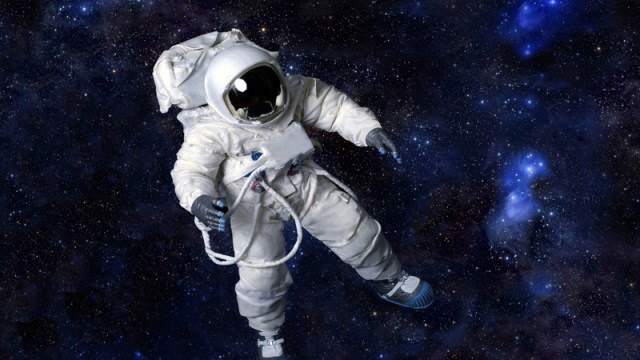When we look up at the night sky sprinkled with thousands-if not millions-of stars, we are actually looking at the remnants of the past. The light from a star has travelled for millions of years before reaching us, and we cannot say with absolute certainty whether or not the star that we see today is actually still present or has gone supernova already. The Apollo 11 landing on the moon on 20 July, 1969 indeed gave impetus to space development.
Every point of light that you and I see on a clear night sky is a sign that the universe is unbelievably huge, and we humans simply cannot be alone. It shows just how possible it is for life of any form to exist on a planet other than our own. It is not like every day we discover a new planetary system or land rovers on planets, but when we do, even one iota of information holds the power to question our understanding about the universe, about us, and change our perspective as to how we thought things worked.
We are earth-people. And, lucky for us, we live on a blue planet, otherwise known as Earth, where water makes up about 71% of the land surface. However, there exists a vast, seemingly endless ocean right above us, and it beholds the secrets it wants us to unravel. We, being the known intelligent species of this planet and our galaxy, see this as our moral responsibility and a golden opportunity to know what place we hold in the universe.
The night sky is, thus, a window showing a universe of endless possibilities.
The Apollo 11 landing on the moon on 20 July, 1969 indeed gave impetus to space development. However, humans saw Neil Armstrong stepping on the lunar surface through their television screens, not with their own eyes. It is when we see with our very own eyes that we realise just how mystical the universe can be. But this begs the question: how many of us have seen the night sky in all its beauty in this Era of light pollution?
Owing to urbanization in the late 20th century, night skies had long been a thing of the past to humans, to an extent that too many people were stranger to seeing real night skies and the word ‘milky way’ was starting to fade away from their vocabulary. This comes from a fact which is both fascinating and astonishing in itself.
In the year 1994, Los Angeles was struck by an earthquake of magnitude 6.7 whose impact was so severe as to cause a total blackout in the whole of LA. The vibrant city of Los Angeles, once brightly lit, was perpetually soaked in darkness with zero light pollution. In the wake of the trembling, the residents citywide found themselves under the open, clear night sky, gazing at what was a foreign thing to them.
For the first time ever, Angelenos were fortunate enough to be able to see the milky way galaxy, our home. Surprisingly enough, most had no clue of what they were looking at and got petrified.
Panicked, some started dialing 911 while others phoned the Griffith Observatory asking, “What is it that I see above me?”.
The next thing we know is that the story of the word ‘milky way’ finding its well-deserved place back in people’s vocabulary shared the headlines with the former earthquake which led to the people uniting with the universe.
What is clear from the said incident is that we do not want to remain heedless of who we actually are-not the citizens of a state or a nation, but we are united in that we’re all part of this universe. Thus, we humans are citizens of planet Earth, residing in the habitable zone of our star which goes by the name Sun, and ours is one of the countless other solar systems comprising the Milky Way galaxy.
Back when space and astronomy was still in its infancy, people believed in Geocentrism–a theory according to which Earth was stated as being placed at the centre of the universe, with the stars, the sun and all other celestial bodies orbiting the earth. It was Nicolaus Copernicus who came up with Heliocentrism which threw light on the fact that the sun is at the centre and all other planets orbit it.
Though his theory received much hostility initially, mainly because it contradicted their religious and philosophical beliefs, it seeded the potential growth of science and astronomy, so much that mankind has today made significant progress in the same ranging from leaving behind footprints on the lunar surface of the moon to making Voyager 1 the farthest human designed spacecraft in space searching for alien life, travelling all the way to the edge of the universe, if there is one.
Over time, space exploration has led to us evolving as intelligent species on this planet to an extent that now we know how the universe we see today was formed in the past, and how it is likely to end in the future. Thus, the reasons for us studying space are many and varied, the main reason being–by studying the universe, we find our place in the cosmos.
Human’s curiosity made us take a leap into space by first sending humans to the moon and then having the International Space Station orbit the earth. We have humans conducting research in the ISS, thereby giving credence to the fact that humans can live outside of the Earth in zero-gravity condition, where people can fly and water floats mid-air.
Not so long ago, the ISS managed to grow an orange zinnia flower in space, making it the first time in space history. Through this, scientists proved that plants can be grown in outer space as well; it also provided us better insight into how plants might have evolved here on Earth.
Astronomy also introduced to us a whole new, fresh perspective as to how we see the Sun. Actually, the sun is already halfway through its lifetime and will continue to light us up for as long as 5 billion years. That may sound like a lot but in astronomical units, it is quite less compared to some other stars in the neighbouring galaxies which have a lifespan of 200 billion years. Little did we know stars have a lifespan.
Now, we have them classified as red dwarfs, yellow dwarfs etc. based on the range of the wavelength of light emitted by them, thus determining the star’s lifespan which ultimately decides the fate of the solar system and the planets in it. The ultimate fate of our sun is that it will ultimately turn into a red giant star and start enlarging, consuming all the planets coming in its way.
That might be the end of our planet which is probably why scientists globally are looking for other ways of generating light here on earth. Countries like China are conducting experiments on nuclear fusion on a large scale, a thermal process using which the sun generates heat and light. The concept of developing ‘artifical sun’ emerged after this discovery came out. Thus, mankind is doing whatever it can possibly do beforehand to keep everyone and everything on this planet safe.
Mankind made one of the greatest accomplishments in space by launching the ‘twin sisters’ namely Voyager 1 and Voyager 2. The former has now officially become the farthest human-made spacecraft in space. On August 20, 1977, NASA launched the Voyager 2 spacecraft to study the four gas giants of our solar system: Jupiter, Saturn, Uranus and Neptune.
While it is true that both the voyagers were meant to study and transmit data on planets inside our solar system, which they sure did for many years, but in 2012, having completed their given tasks successfully, Voyager 1 entered interstellar space, meaning it went outside of our solar system. In 2018, the same happened with Voyager 2. Both the spacecrafts left our solar system with the mission to study interstellar space, never to return back to earth.
Interestingly enough, both the ‘sister spacecrafts’ carry with them what is known as the Golden Record, just in case we encounter any intelligent form of life outside of our solar system. The Golden Record is a 12-inch gold-plated copper disk and it has in it all the information about us, Earth and all the living beings present on it, and it seeks to give the message that the human race wants amicable relation with all other extraterrestrial forms of intelligent species present outside of our solar system.
The Golden Record is no ordinary disk in that it contains spoken greetings from Earth in 55 different languages, and not just an ordinary “hello” but a unique way to show that human beings are both cordial and innovative. It also has images, videos and sounds of nature, animals, birds, insects alongside a 90-minute long music which is again taken from different cultures and eras.
The sole objective of putting something like this on a spacecraft is to let the aliens know we mean no harm and that there is a blue planet where yet another group of intelligent species thrives.
Time and again, space agencies across the globe launch probes and rovers on planets such as Mars. Their findings suggest that Mars may have had life on it in the past, or may not. Either way, the red planet will probably have life on it in the future. Mars is of interest to us as, unlike other planets, it lies within the Sun’s habitable zone just like our Earth.
What makes Mars different from Earth is that it’s closer to the sun and the sunsets on Mars are pink and not red. Thus, more and more research is being conducted with the prospect of colonizing Mars. We want to do so as the human population on earth is increasing at an alarming rate and though Mars is half the size of earth, it will meet our requirements.
Not wanting to put too much environmental and economical stress on our planet, the idea is to relocate some of our population to a neighbouring planet. The only problem lies in discovering ways to keep us alive there since there are no trees, just barren lands which scientists are working to convert into fertile agricultural fields. As a result. NASA has recruited four people for their Mars Simulation Mission in which the recruits will experience on earth what it is like living on Mars.
Our yet another motive behind studying other planets and moons, such as Titan, one of Saturn’s moons, is to find signs and/or evidences of extraterrestrial life of any form. Even bacteria found on some other planet would indicate the presence of life since bacteria is a unicellular living organism. Thus, more research can be carried out on the conditions under which life may have evolved here on earth.
The Hubble Telescope launched in the year 1990 provided us insight into the distant galaxies and the universe as a whole. A more advanced telescope, the James Webb Space Telescope, launched in the year 2021 is also the most expensive telescope ever built by humans.
The estimated expense is to be somewhere around 10 billion dollars. So far, Webb has sent innumerable images which includes, but is not limited to, the pillars of creation, a cluster of early galaxies, just to name a few. The colourful and vibrant image of the famous butterfly nebula was captured in 2009 by none other than The Hubble Space Telescope.
Both the telescopes reveal to us what the universe looked like in the past, the nebulae which are the birthplace of young stars and so many other facts relevant to our interest. Moreover, our telescopes have helped us confirm the existence of black holes, helping us to conclude that time slows down near such massive objects. It is because of our launching powerful telescopes that scientists can estimate the age of our universe which is roughly 14 billion years old.
Additionally, space exploration enabled scientists to come up with the Big Bang Theory which explains the origin of the universe. It states that the universe originated from a single point of infinite density and has been expanding ever since.
Also, it helps us identify potential dangers lurking in the universe such as asteroids. Today, we have come to the point that we can actually locate and track where exactly a given asteroid is and its future trajectory, and whether or not it will ever pose a threat to our planet.
We have already had dinosaurs disappear from the face of the earth due to an asteroid collision, we simply cannot afford to lose yet another intelligent species of earth. Thus, recently NASA launched the Double Asteroid Redirection Test (DART) mission in which a spacecraft was sent to collide with an asteroid, Dimorphos, to change its course. This proves that mankind is capable of detecting any Potentially Hazardous Object(PHO) such as an asteroid, and then changing its trajectory so as to prevent any chance of its collision with the Earth.
Moreover, our planet is undergoing serious climatic and environmental changes. We are working towards tackling this global challenge of climate change but just to be on the safe side, we are constantly looking for planets better than our own.
We have a decent number of observatories which are located in areas with minimal light pollution. The W.M. Keck Observatory located in Hawaii, for example, sent data of an exoplanet-KOI 5b-which is 3,000 light years away from us whose star’s lifespan is about 70 billion years. Chances are it consists of oceans meaning it is a superhabitable world.
Thus, we look for planets having optimum conditions for life because in case we have to find another planet, we might as well relocate to one of these planets. While this may sound improbable and something straight out of a science fiction, history shows that everything we have achieved in the field of space up until now was unthinkable and unimaginable to people a century ago.
Back in the year 1054, people from different cultures across the globe witnessed the appearance of a new star, bright enough to be visible with naked eyes during daytime, or so they thought. Now, using our powerful telescopes we have figured that the famous Crab Nebula is present where the supernova of the star took place, something which humans mistook for the birth of a new star about a thousand years ago.
Clearly, space exploration is the future of humanity, the reasons for which are clear now. Our telescopes have helped us find planets completely made out of water. Were it not for these telescopes, we would have not known it rains diamonds on Uranus and Neptune. To sum up, the universe abounds in treasures and these cosmic treasures are a gift from the universe that we must preserve.
Should we find ways to extract minerals or water from these planets, it will meet the needs of people here on earth. Besides, space development has made us learn that the Earth is such a beautiful place to live in, with all its imperfections, because it has little of everything in it. As a matter of fact, on February 14, 1990, i.e., on Valentine’s Day, Voyager 1 turned towards us one last time before its cameras were shut down permanently. It sent us one last image showing the earth as a ‘pale blue dot’.
Earth appears as a point in the image but in reality, we know there is much more to the planet than what meets the eye. To conclude, space development and exploration has opened new doors for the future of mankind but it has also made it clear there is no planet B, and while we continue to land humans on other planets, welcoming aliens with open arms, we are also working to build a better future for all by keeping our first home safe.
By: Srishti Suman Gupta
Write and Win: Participate in Creative writing Contest & International Essay Contest and win fabulous prizes.

















